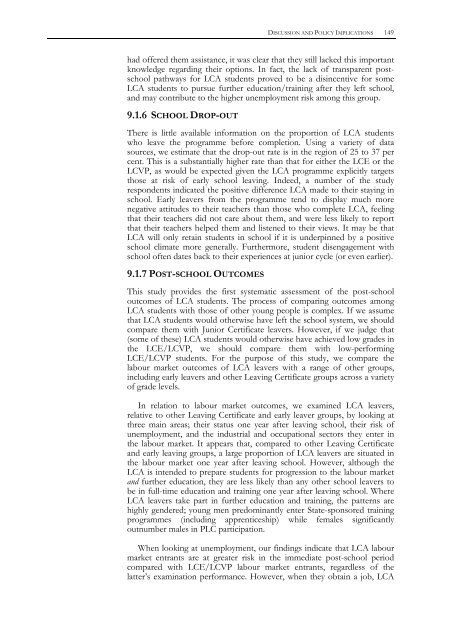Student Experiences of the Leaving Certificate Applied Programme
Student Experiences of the Leaving Certificate Applied Programme
Student Experiences of the Leaving Certificate Applied Programme
You also want an ePaper? Increase the reach of your titles
YUMPU automatically turns print PDFs into web optimized ePapers that Google loves.
DISCUSSION AND POLICY IMPLICATIONS 149had <strong>of</strong>fered <strong>the</strong>m assistance, it was clear that <strong>the</strong>y still lacked this importantknowledge regarding <strong>the</strong>ir options. In fact, <strong>the</strong> lack <strong>of</strong> transparent postschoolpathways for LCA students proved to be a disincentive for someLCA students to pursue fur<strong>the</strong>r education/training after <strong>the</strong>y left school,and may contribute to <strong>the</strong> higher unemployment risk among this group.9.1.6 SCHOOL DROP-OUTThere is little available information on <strong>the</strong> proportion <strong>of</strong> LCA studentswho leave <strong>the</strong> programme before completion. Using a variety <strong>of</strong> datasources, we estimate that <strong>the</strong> drop-out rate is in <strong>the</strong> region <strong>of</strong> 25 to 37 percent. This is a substantially higher rate than that for ei<strong>the</strong>r <strong>the</strong> LCE or <strong>the</strong>LCVP, as would be expected given <strong>the</strong> LCA programme explicitly targetsthose at risk <strong>of</strong> early school leaving. Indeed, a number <strong>of</strong> <strong>the</strong> studyrespondents indicated <strong>the</strong> positive difference LCA made to <strong>the</strong>ir staying inschool. Early leavers from <strong>the</strong> programme tend to display much morenegative attitudes to <strong>the</strong>ir teachers than those who complete LCA, feelingthat <strong>the</strong>ir teachers did not care about <strong>the</strong>m, and were less likely to reportthat <strong>the</strong>ir teachers helped <strong>the</strong>m and listened to <strong>the</strong>ir views. It may be thatLCA will only retain students in school if it is underpinned by a positiveschool climate more generally. Fur<strong>the</strong>rmore, student disengagement withschool <strong>of</strong>ten dates back to <strong>the</strong>ir experiences at junior cycle (or even earlier).9.1.7 POST-SCHOOL OUTCOMESThis study provides <strong>the</strong> first systematic assessment <strong>of</strong> <strong>the</strong> post-schooloutcomes <strong>of</strong> LCA students. The process <strong>of</strong> comparing outcomes amongLCA students with those <strong>of</strong> o<strong>the</strong>r young people is complex. If we assumethat LCA students would o<strong>the</strong>rwise have left <strong>the</strong> school system, we shouldcompare <strong>the</strong>m with Junior <strong>Certificate</strong> leavers. However, if we judge that(some <strong>of</strong> <strong>the</strong>se) LCA students would o<strong>the</strong>rwise have achieved low grades in<strong>the</strong> LCE/LCVP, we should compare <strong>the</strong>m with low-performingLCE/LCVP students. For <strong>the</strong> purpose <strong>of</strong> this study, we compare <strong>the</strong>labour market outcomes <strong>of</strong> LCA leavers with a range <strong>of</strong> o<strong>the</strong>r groups,including early leavers and o<strong>the</strong>r <strong>Leaving</strong> <strong>Certificate</strong> groups across a variety<strong>of</strong> grade levels.In relation to labour market outcomes, we examined LCA leavers,relative to o<strong>the</strong>r <strong>Leaving</strong> <strong>Certificate</strong> and early leaver groups, by looking atthree main areas; <strong>the</strong>ir status one year after leaving school, <strong>the</strong>ir risk <strong>of</strong>unemployment, and <strong>the</strong> industrial and occupational sectors <strong>the</strong>y enter in<strong>the</strong> labour market. It appears that, compared to o<strong>the</strong>r <strong>Leaving</strong> <strong>Certificate</strong>and early leaving groups, a large proportion <strong>of</strong> LCA leavers are situated in<strong>the</strong> labour market one year after leaving school. However, although <strong>the</strong>LCA is intended to prepare students for progression to <strong>the</strong> labour marketand fur<strong>the</strong>r education, <strong>the</strong>y are less likely than any o<strong>the</strong>r school leavers tobe in full-time education and training one year after leaving school. WhereLCA leavers take part in fur<strong>the</strong>r education and training, <strong>the</strong> patterns arehighly gendered; young men predominantly enter State-sponsored trainingprogrammes (including apprenticeship) while females significantlyoutnumber males in PLC participation.When looking at unemployment, our findings indicate that LCA labourmarket entrants are at greater risk in <strong>the</strong> immediate post-school periodcompared with LCE/LCVP labour market entrants, regardless <strong>of</strong> <strong>the</strong>latter’s examination performance. However, when <strong>the</strong>y obtain a job, LCA

















